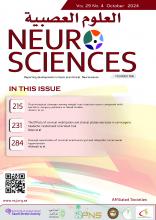To the Editor
We have read with interest Almegren et al’s article about a multicentre retrospective hospital chart-based study on the outcomes of 103 patients with venous sinus thrombosis (VST) collected from 2006 to 2020 in two tertiary centres in Saudi Arabia and Oman.1 Two-thirds of patients received low-molecular-weight heparin and 76% were discharged with warfarin.1 Complete resolution of the thrombus occurred in 36% of 55 patients.1 The majority of patients had no or only mild neurological disability, 17% had seizures, 6 patients had a modified Rankin Scale (mRS) score ≥3, and one patient died.1 The study is excellent, but some points need discussion.
The first point is the retrospective design of the study.1 Retrospective designs have the disadvantage that some data may be missing, the accuracy of the data cannot be easily checked, desired missing or new data can no longer be generated, and clues for specific investigations are often not comprehensible. A retrospective design also does not allow for follow-up studies. We should know how many patients had to be excluded due to missing data, how many were included despite missing data, and to what extent this affected the results.
A second point is that the mRS was used as an outcome measure. A weakness of mRS grading is its potential for inter-observer variability.2 Inter-observer variability implies misclassification of the endpoint and can weaken statistical power.2 We should know whether the inter-observer variability was calculated for the mRS and whether it was acceptable or not. We should also know whether other stroke outcome scales were used, such as the NIHSS, the Canadian neurological scale, the Barthel index, or the Functional Independence Measure.
A third point is that several common complications of VST were not analysed. The most common VST complications not analysed include headache, papilledema with consecutive optic neuropathy, subarachnoid bleeding, and subdural bleeding.3 We should therefore know how many of the 103 patients included had headaches or visual disturbances and how many of the major bleeding events were classified as subdural or subarachnoid bleeding.
A fourth point is that the causes of VST have not been reported. We should know how many patients had VST due to infection, traumatic brain injury, iron deficiency, malignancy, dehydration, obesity, oral contraceptives, Crohn’s disease, intracranial hypotension, or pregnancy.4 Was the outcome different regarding VST etiology?
A fifth point is that it is unclear how VST was diagnosed. We should know whether VST was diagnosed in all patients using magnetic resonance venography (MRV) or also computed tomography venography (CTV). In this context, we should also know whether CTV or MRV images were reviewed for correctness of diagnosis or whether patients were included solely based on the written imaging results?
A sixth point is that the observational period also included 2020, the first year of the SARS-CoV-2 pandemic.1 Since SARS-CoV-2 infection (SC2I) can be complicated by VST,5 we should know whether the prevalence of VST has increased compared to previous years. SC2I-associated VST occurs particularly in older patients with fewer classic risk factors for VST.5
In summary, the interesting study has limitations that put the results and their interpretation into perspective. Removing these limitations could strengthen the conclusions and reinforce the study’s message.
Reply from the Author
We would like to thank Zarrouk et al for their correspondence on our article “Outcomes and complications of patients with cerebral venous thrombosis: a retrospective study.” We agree with Zarrouk and colleagues about the disadvantages of retrospective studies. However, in this paper we have used clear inclusion criteria that were described in the methods section, which helped to identify patients with the required data. In the results section, we mentioned the missing mRS data for 5 patients. We opted to use the mRS due to the ease of score retrieval from the patients’ electronic files, although a more complex outcome scale with detailed points to calculate would be helpful in prospective studies. Headache and papilledema are common symptoms in clinical presentation of patients with CVT; however, we were focused on such functional and major outcomes as recurrent CVT, stroke, and bleeding. All patients were included based on an official radiological report (CT/MRI) confirming the diagnosis. We did not consider the CVT rate change after COVID-19, although this would be an interesting point to address in future research.
- Copyright: © Neurosciences
Neurosciences is an Open Access journal and articles published are distributed under the terms of the Creative Commons Attribution-NonCommercial License (CC BY-NC). Readers may copy, distribute, and display the work for non-commercial purposes with the proper citation of the original work.






